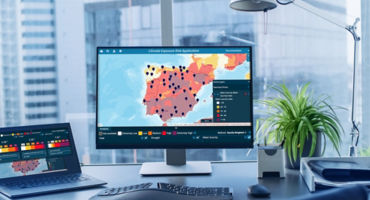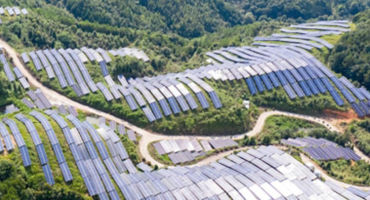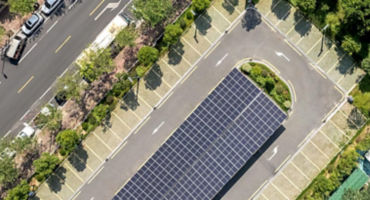- Portfolio Manager
Skip to main content
- Funds
The views expressed are those of the author at the time of writing. Other teams may hold different views and make different investment decisions. The value of your investment may become worth more or less than at the time of original investment. While any third-party data used is considered reliable, its accuracy is not guaranteed. For professional, institutional, or accredited investors only.
From devastating floods in Australia — tragically, in many of the same areas hit by fires in recent years — to wildfires in Europe and the US, widespread disasters bring into stark reality the consequences today of a changing climate. The human toll of these events has become an unfortunate yet familiar part of the news cycle, but the second-order impacts of climate change on financial markets are sometimes less well understood. Many traditional approaches to climate investing have rightly focused on these risks, but we believe their approach, and their scope, is often incomplete and lacking nuance, thereby creating inefficiencies in the climate-investing landscape.
In this piece, we outline our views on the climate opportunity set as climate change increasingly has the potential to disrupt entire industries.
Properly defining the climate opportunity
The wall of capital pursuing ESG opportunities has been important in tackling these issues to date but has also had unintended outcomes for markets. This influx of capital is “good” in that it finances companies that we believe are already positively contributing to the mitigation of or adaptation to climate change. However, it mostly affects companies that currently meet materiality thresholds for inclusion in today’s ESG-mandated strategies and ETFs. Crucially, these approaches typically exclude companies that do not meet those metrics today, even if they are actively moving us toward a greener world by making investments in R&D, changing product lines, and transforming business models. For example, metals producers often score poorly from a carbon emissions/ESG perspective and may therefore be excluded. However, we believe some metals producers, like those for aluminum, may require a more nuanced lens. Aluminum has key uses in electric vehicles (EVs), solar power generation, climate-resilient physical infrastructure, electric grid infrastructure, and other renewable technologies. There are many potential decarbonization winners in areas such as these that we believe are not properly reflected in today’s metrics.
In our view, the backward-looking nature of most of these approaches ignores the future, resulting in a large segment of the market being underappreciated. This creates an unusual situation, as one of the basic tenets of investing is valuing a company based on its future prospects. By placing such a high value on a company’s ESG credentials today, including using them as the basis for negative screens, investors may be ignoring the ESG winners of tomorrow.
In our view, this market dynamic has generated a significant inefficiency (and opportunity) for more dynamic approaches in the form of “false negatives” and “false positives.”
Understanding the market inefficiencies in climate investing
“False negatives” include companies that, in our view, are successfully transitioning their business models to be greener, have compelling fundamentals and are trading at attractive valuations, partly because they do not meet the current bar for inclusion in ESG-mandated approaches. For example, consider an automotive company that is successfully pivoting to the production and sale of EVs, but whose EV revenues do not meet the common 50% or greater threshold for inclusion in an impact fund, even if it will likely meet those thresholds within an investable time horizon.
In contrast, “false positives” include companies that currently appear to be climate advantaged, but that we believe may not be in the future. For instance, some may have poor or deteriorating fundamentals, may not have sustainable competitive advantages or may trade at elevated valuations, in part because they meet materiality thresholds for inclusion in ESG-mandated approaches. An example of a company with this “halo effect” could be an EV-focused SPAC that we believe does not have a durable competitive advantage in a space that is ripe with competition from both legacy companies and new entrants.
Figure 1 shows how we view this broader climate opportunity set, including the “false negatives” and “false positives” described above, as well as the companies we believe are “true positives” and “true negatives.”
Understanding the climate opportunity set
True Posities
False Negatives
True Negatives
False Positives
The climate opportunity set is, in our view, much broader and more dynamic than that of traditional climate strategies. Moreover, we believe today’s environment and existing strategies create a growing dispersion between relative price and value, meaning a more nuanced approach to climate investing is likely to be increasingly critical in the years ahead.
Experts



Picking the right building blocks for a climate-aware portfolio
Continue readingA blueprint for building climate-aware multi-asset portfolios
Continue readingURL References
Related Insights

2023 Climate Report

2023 Sustainability Report
We appreciate the opportunity to share our approach to advancing sustainable practices across our investment, client, and infrastructure platforms.

Picking the right building blocks for a climate-aware portfolio
For asset owners integrating climate change into their multi-asset portfolios, members of our Investment Strategy & Solutions Group offer five important insights.

A blueprint for building climate-aware multi-asset portfolios
Members of our Investment Strategy & Solutions Group take a deep dive on the issues asset owners should consider when choosing climate-aware portfolio building blocks, from the evolving opportunity set to the active/passive decision.

Climate mapping in action: Investment case studies
We describe our Climate Exposure Risk Application (CERA), which can help our investment teams visualize and quantify physical climate risks.

Private investing portfolio company interview with AMP Robotics CEO
Dr. Matanya Horowitz, CEO of AMP Robotics, highlights how the company integrates AI and robotics into the recycling industry and explores the “actionable guidance” Wellington provides on ESG and other strategic issues.

Why sustainable food systems matter to investors
Our climate research expert explores insights from our joint work with Woodwell Climate Research Center on the pivotal relationship between food systems and biodiversity and highlights potential investment opportunities.

Why climate change matters in private markets

When extreme weather becomes the norm: what’s next for climate investors?
Climate investors can play a crucial role in accelerating mitigation and adaptation solutions. But finding investable opportunities requires a deep understanding of the climate investing landscape.

WellSaid: The economic significance of biodiversity
In this short clip from his WellSaid podcast interview, Dr. Zach Zobel of Woodwell Climate Research Center discusses the economic importance of coral reefs — lynchpins of marine biodiversity and vital to fishing, tourism, and other industries.

In our view, climate change is a macro catalyst with the potential to disrupt entire industries, producing both relative winners and relative losers. Market-neutral strategies may offer the potential to capitalize on both.
URL References
Related Insights